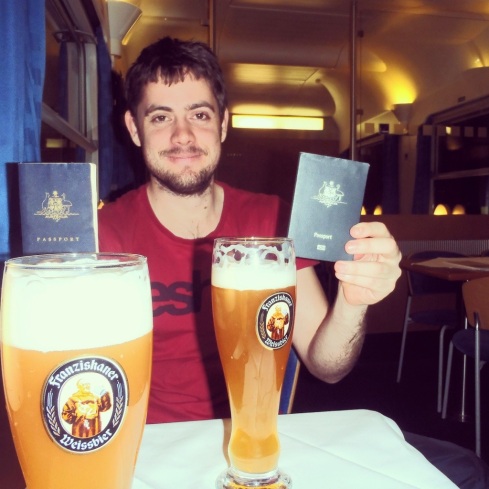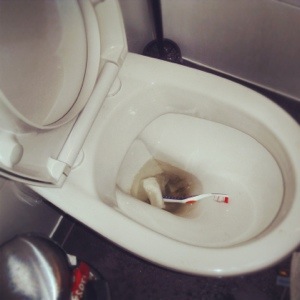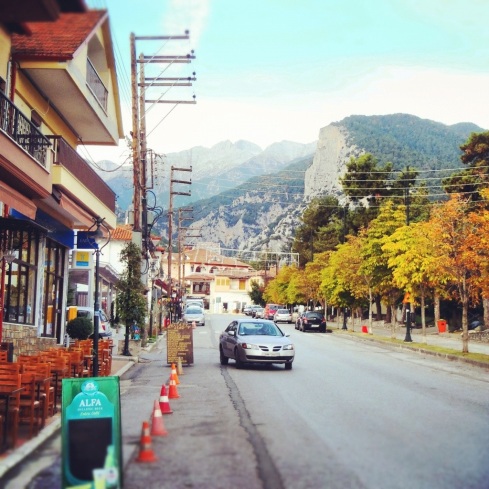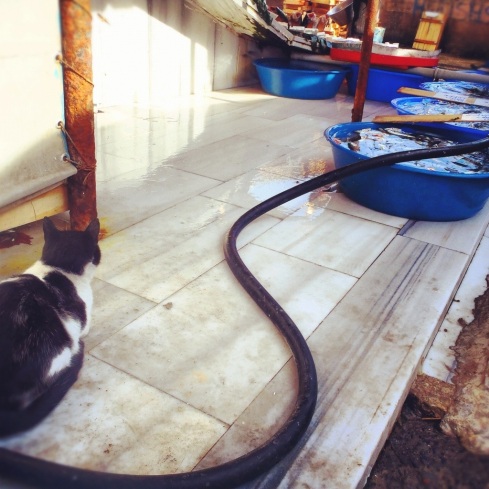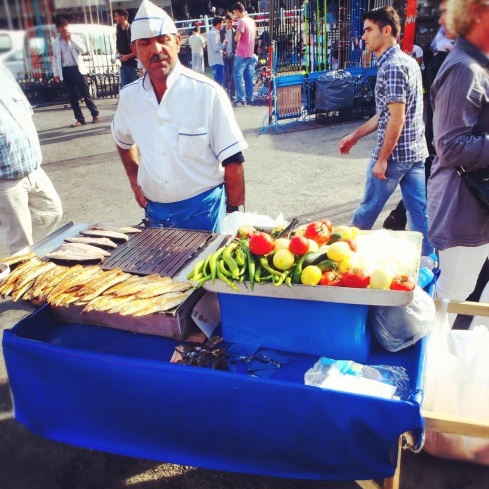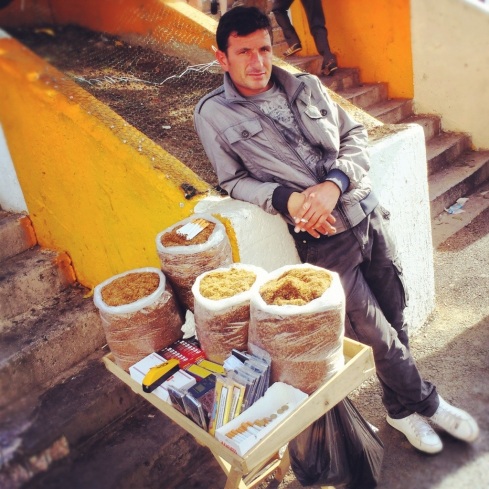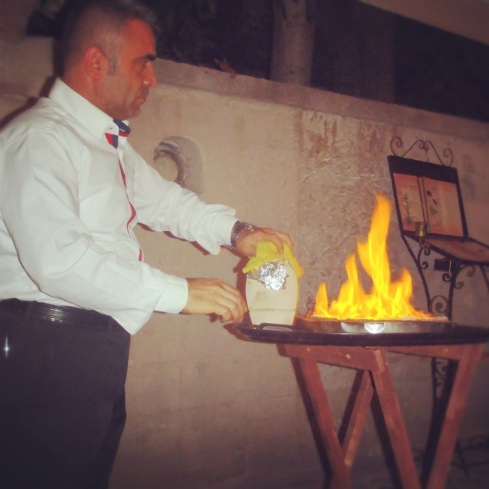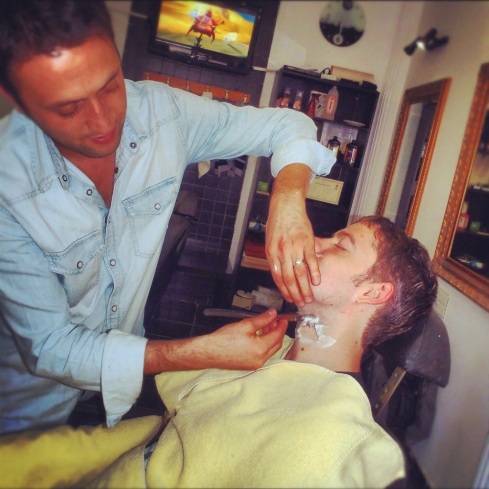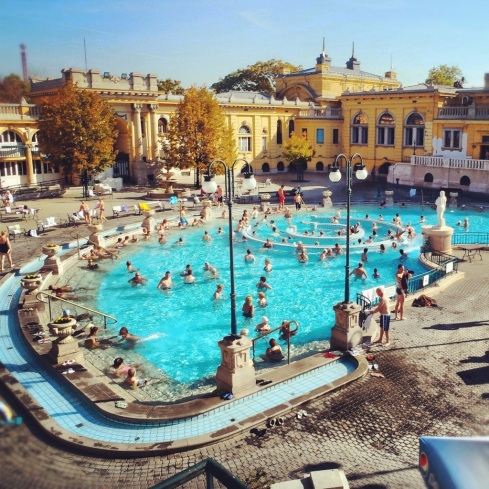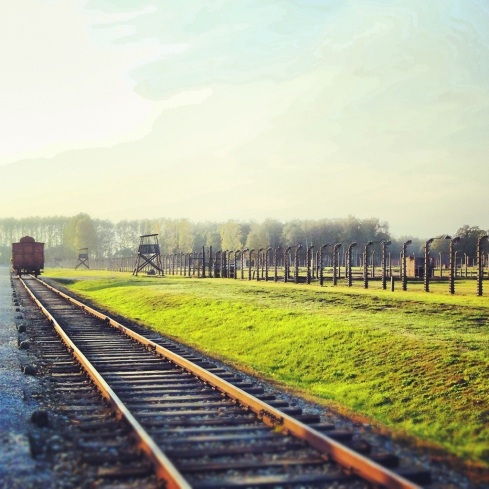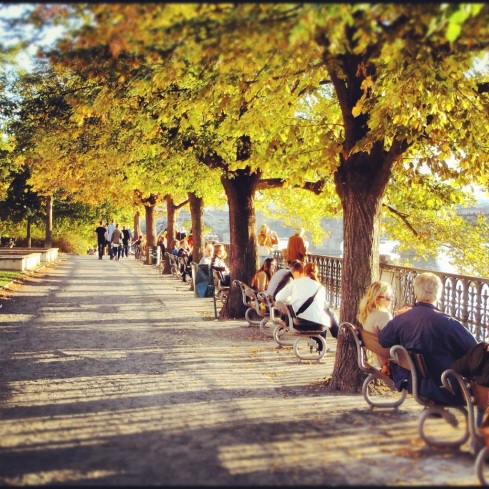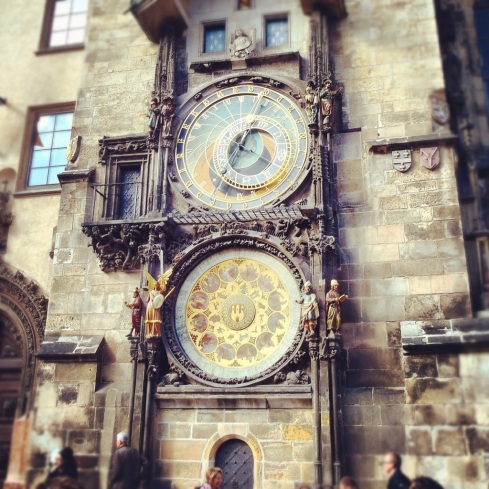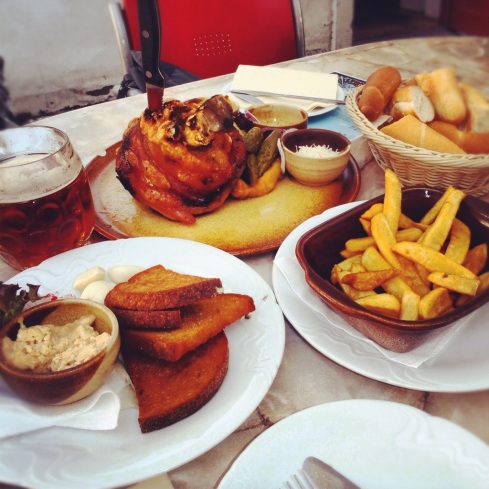THE woman silently beckons me from my lonely seat in a back room of the bar. I’m the last one left and it’s dim and gritty in here, but no more so than what seems to be the standard in this perplexing city. I follow, touching the outline of a smooth, brass coin through my left pants pocket. She stands behind me and places her hands gently on my shoulders and says ‘Close your eyes, I am going to blindfold you now.’ She has a kind voice. After about 20 steps we stop and she tells me that I am to go inside the doors, place my coin into the slot and wait for instructions. She removes my blindfold, I enter the darkness and hear the doors close behind.
I take the coin from my pocket.
The rules at Peristal Singum are simple. Just breathe, try not to rush. If you start to panic, wait, someone will eventually save you.
 Waiting to enter Peristal Singum
Waiting to enter Peristal Singum
Located inside the Salon Zur Wilden Renate in Berlin’s east-lying suburb Friedrichshain, Peristal Singum accurately summarises for me the past week’s experiences in Germany’s alternative capital – unique, unexpected, sometimes unsettling, but overwhelmingly awesome.
However, like most things Berlin, the appeal behind this playground for adults can be attributed as much to the shroud of exclusivity its’ organisers have created around it as to the quality of the experience itself.
You only need look at the sphincter-like door policy of the majority of nightclubs in the City to understand this concept. Techno club Berghain is world renowned for its fear-invoking bouncers and utterly inexplicable dress-code. The club is inside a derelict building, not unlike the Old South Fremantle Power Station, for those familiar. You walk through a pile of dirt and mud to queue in the cold, inside what looks like a cattle barrier. Then you will come face to face with two or more terrifying doormen, one with extensive barbed wire facial tattooing and grills on his teeth. Depending on what side of bed they got up on that morning (or so it seems) you will either enter or be rejected and the rejection rate can be up to 90% on any given night.
It probably sounds like sour eggs, because the bouncers took one look at us and the tall muscular, blonde one, who looked like his name was Sven, said ‘You’re not coming in here tonight’ and that was it. The dream was over, crushed, annihilated. We were left sobbing by the side of the road, listening to the throbbing bass emanating outward from inside that beautiful, unattainable, brown brick building.
No one can get in, so it must be awesome, right?
We may never know.
We dragged our sorry asses to another club, Cassiopeia and danced with a room full of Rastafari to Reggae music until 5 am and had an unexpectedly awesome night.
In interviews with owners and founders of other door-strict clubs like Tresor and Watergate, the question is always asked, ‘What’s with the door policy?’ The interviewees always reject any claims of discrimination based on nationality, sexual preference etc, simply responding that they like to ‘keep the right mix’ of patrons.
The observance of this attitude gives valuable insight into this City’s sentiment toward its gradual commercialisation.
While overused, the words grungy and gritty are perfect for this still-emerging city. Sebastian, a pretty cool tour guide who showed us everything from the Brandenburg Gate and Holocaust Memorial to the very window from which MJ dangled baby Blanket in 2002 told us, ‘Berlin is Germany’s problem child.’ It’s no wonder, really, when you look at the way a very important series of events in European history was played out over a short space of time, right in this very City – so very recently.
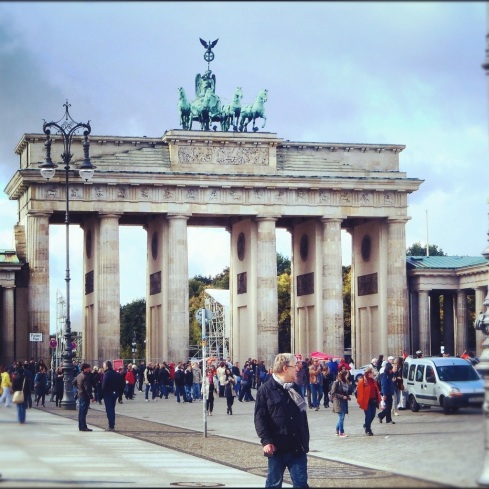 Brandenburg Gate
Brandenburg Gate
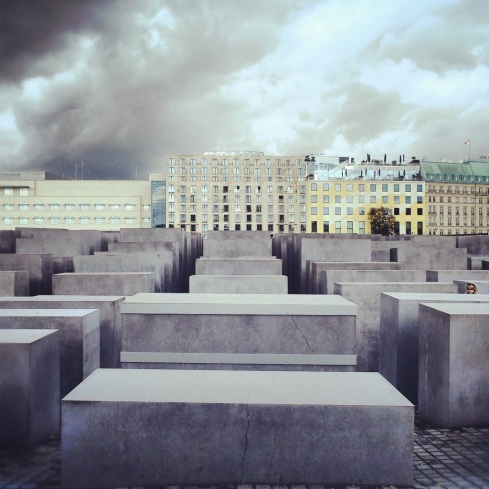 Holocaust Memorial – very solemn and moving
Holocaust Memorial – very solemn and moving
 Hotel Adlon – made infamous by the Michael Jackson baby-dangling incident
Hotel Adlon – made infamous by the Michael Jackson baby-dangling incident
Firstly, much of Berlin was destroyed during the final years of World War II. Hitler’s bunker and place of death lies anonymous and defunct, filled in with rubble, under a weed-ridden and crumbling car park belonging to a group of red-roofed communist era flats.
After the war, when the Allies split Germany into four occupation zones, unfortunate Berlin was also split, with Checkpoint Charlie and the Berlin Wall (anti-fascist protection rampart) becoming the poster-child for Europe’s 40-year long Iron Curtain. West Berlin, under Allied occupation, was secluded inside Communist East Germany. While parts of the Berlin Wall remain as a chilling reminder of life under Soviet rule for East Germany, it was the same wall that cultivated present-Berlin’s unique identity. The free-thinking, non-conformist culture that began to blossom in uber-democratic West Berlin exploded into East Berlin after Germany’s reunification in 1990. The West German Government could not restore order to East Berlin immediately and East Berlin was treated like a playground for artists, musicians and creative types, who squatted and utilised disused buildings for hedonistic pursuits.
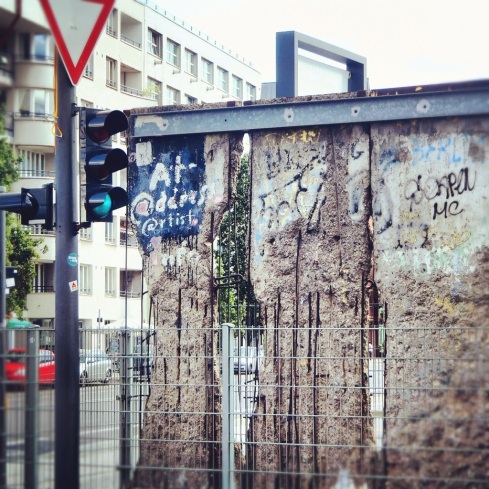 Berlin Wall remnant
Berlin Wall remnant
Despite gradual gentrification to its streetscapes and buildings, referred to by resistant inhabitants as ‘Disneyfication,’ Berlin’s history is rich and its unique culture has remained strong, the main drawcard for travellers and tourists.
 Friedrichshain train station – perfectly grungy
Friedrichshain train station – perfectly grungy
But in my mind, there lies a two edged sword. Some Berliners see this increased tourism and modernisation as a threat to their City’s identity and to their way of life. (The root of Berlin’s crazy club door policies?) But, as Germany’s most debt-ridden City, economically, it could really do with the cash and its Government knows it – implementing the successful advertising slogan ‘Poor But Sexy’ in 2009.
A few (million) tourists and a lick of paint aside, To the outsider at least, Berlin’s grunge-factor is alive, well and as appealing as ever.
While West Berlin has caved to the Golden Arches, allowing the US giant to stamp its greasy name just a stone’s throw from Checkpoint Charlie, there is some healthy resistance on the other side of town – the promotion van belonging to a schnitzel shop close to the East Side Gallery has the words ‘Fuck Ronald &Co’ emblazoned on the side.
 Checkpoint Charlie – US military checkpoint between East and West Berlin between 1945 and 1989
Checkpoint Charlie – US military checkpoint between East and West Berlin between 1945 and 1989
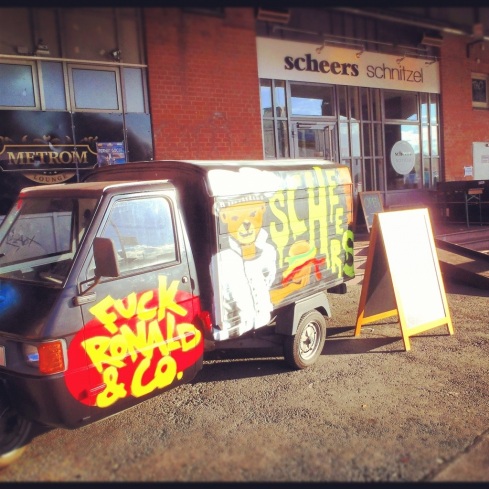 Great home made schnitzel burgers… Definitely not Maccas!
Great home made schnitzel burgers… Definitely not Maccas!
But where the rest of the world has McDonald’s, Berlin has Curry-Wurst. Think brotwurst with a slathering of ketchup, all snowed under by… Curry powder. I ate it once, was not a fan, twice and it grew on me, three times, well, you get the rest. Sold in bread or with frites (chips) for about €2.50, I would love to find out if anyone is selling this back in Perth. Kebabs are also a popular fast food in Berlin, with a shop on every corner, all open late to feed the throngs of party goers turfed out from bars and clubs.
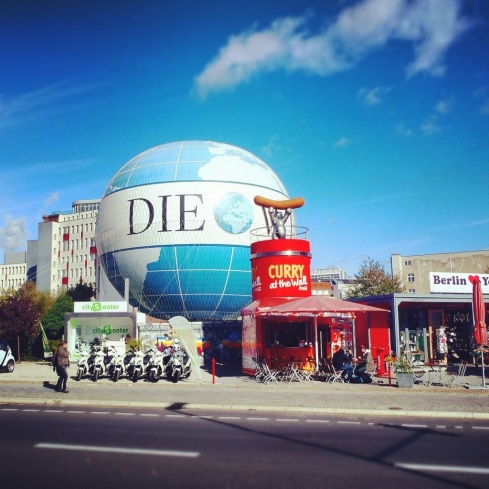 One of many curry wurst shops
One of many curry wurst shops
Many bars are still housed inside dilapidated buildings, unrecognisable as such from the outside. Other drinking holes are themed in novel ways. With bat in one hand and beer in the other, we played hilarious knock-out table tennis at Dr Pong bar, which is basically two sparse adjoining rooms, one with a bar and the other a ping pong table and a few chairs. This has to be the most innocent fun you can have with 30 complete strangers. At rock and metal bar Last Cathedral, the drinks menu included Absinthe-Red Bull shots and shots with Tabasco, but at least those experiencing impending death from these concoctions could feel at home amongst the skulls, coffins and crypts the place was decked out with.
 Last Cathedral bar – beers poured from skulls!
Last Cathedral bar – beers poured from skulls!
And if that’s not seedy enough for you, Berlin’s drug dealers do actually hang out in dark alleys in the dead of the night.
On our way home one night we had the pleasure of meeting Willy, a Tunisian ‘Coke’ dealer cum drug mule. He thrust a freshly bought takeaway plate of chicken and chips into my hands and quickly disappeared, apparently to get his wares, hidden in ‘the dirt,’ so he said. So we are standing on the street holding this guy’s dinner, wanting to leave, but not knowing what to do, when he returns, takes back the plate and holds out a chicken loaded fork to myself and Nic, saying ‘eat some, eat some… You are my friends! My mouth hasn’t touched that bit.’
Make of it what you will, but we took ‘in the dirt’ to mean ‘up the back passage’ and were laughing, while walking away with Willy following us, holding out a handful of small, dirt-covered, green packages. It turns out that ‘in the dirt’ actually meant buried in the sand and his ‘Coke’ was in fact white sugar, so it’s no wonder this poor guy had to run drugs between Berlin and Amsterdam multiple times per week to get by!
So Berlin, a wonderful convergence of old and new, freezing cold, where bicycle fever has taken over, a war time wall is now a public art piece, the City’s fairly ugly TV tower is affectionately nicknamed ‘Alex,’ Berlin-style reigns supreme and recycling is king. Love it.
 Bikes chained up everywhere
Bikes chained up everywhere


 Parts of the 1.6 km stretch of Berlin Wall called the East Side Gallery
Parts of the 1.6 km stretch of Berlin Wall called the East Side Gallery
 TV tower ‘Alex’
TV tower ‘Alex’
HOSTEL
Plus Berlin Hostel, Warschauer Platz 6, Berlin
Everything! Huge rooms with fridge and microwave, pool, sauna, bar and restaurant, at least one awesome bar tender. There was a cat staying in the room next door to us and the hostel kept rabbits. Generally an awesome place to run amok and only 200 metres from Berlin’s answer to Metro’s Fremantle – Matrix Club… Oh wait, that should be in the cons section…
Drinks were pricey in the bar and they kept playing Jazz music when everyone was trying to get amped to go out.
 Hostel room
Hostel room
TIME SPENT SO FAR…
In the air – 24.5 hours
Total travelling including flights, buses, airport time – about 83 hours
41.029097
28.979572
Tags: Australia, Backpacking, Berghain, Berlin, Berlin Wall, Cassiopeia, Checkpoint Charlie, curry wurst, East Side Gallery, Gentrification, Germany, Hitler, Peristal Singum, Perth, Plus Berlin Hostel, travel, Tresor, Watergate, World War II
